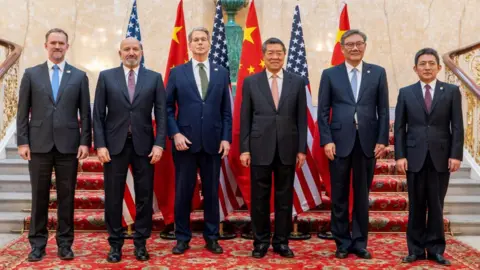The recent negotiations between the United States and China have concluded with an agreement framework aimed at easing trade tensions that have characterized their relationship in recent years. This meeting took place in London, where high-level officials from both nations engaged in discussions aimed at addressing key trade issues. Central to these talks was the future of rare earth minerals and their associated tariffs, which have significant implications for both economies.
US Commerce Secretary Howard Lutnick announced that, based on the discussions, there is a clear plan to resolve restrictions on rare earth minerals and magnets, which are critical for technology sectors. This agreement will subsequently be submitted to the presidents of both countries—Donald Trump from the US and Xi Jinping from China—awaiting their final approval. The negotiations represent a crucial step toward normalizing trade relations, which have been strained after a series of tariff increases and accusations from both sides concerning breaches of previous agreements.
The framework discussed also covered critical exports, particularly those related to rare earth minerals, which are essential for manufacturing a wide range of modern technologies—from smartphones to electric vehicles. Notably, data from the previous communications between the two nations indicated a temporary truce over trade tariffs. However, both countries have exchanged accusations regarding non-compliance, indicating that trust remains fragile.
In the wake of these talks, the US has highlighted its concerns that China has been lax in exporting necessary rare earth materials, which are vital for its manufacturing sectors. Conversely, China has responded by pointing out that the US has enforced restrictions on critical exports such as semiconductors and AI-related technologies that would impede Chinese companies.
Lutnick, during a press conference, expressed optimism regarding the potential for resolving these longstanding disputes. He emphasized the foundational aim of reaching an implementation framework based on the consensus achieved during a recent phone call between Trump and Xi, which both leaders described as productive. China’s Vice Minister of Commerce, Li Chenggang, reiterated this sentiment, indicating that a mutual understanding was reached, reflecting a significant development in their ongoing dialogue.
These current talks follow mixed points of progress and regression from earlier this year; although an initial truce had reduced tariffs significantly, both sides reported persistent grievances about adherence to non-tariff agreements.
The contentious nature of US tariffs imposed on Chinese goods has further complicated relations. Earlier in the year, those tariffs spiked, with figures hitting dramatic percentages. For example, the imposition of tariffs increased to 145% in a highly publicized escalation. The response from China was to levy its own tariffs, thereby creating a tit-for-tat response that significantly hurt economic relations.
Despite the backdrop of past grievances, the recent promise of cooperation—evident from the softening stance on restrictions by both nations—illustrates a potential turnaround. Previous dialogues have hinted at progress but have often been undercut by each side’s accusations of violations and non-compliance.
The negotiations also highlight the critical role of rare earth materials in global technology supply chains, emphasizing their importance beyond mere trade economics. The upcoming presidential approvals will mark a pivotal moment for US-China relations and may signal a new chapter in their trade interactions, contingent on the goodwill established during these high-stakes discussions.
Overall, the prospects of reestablishing cooperation in trade are cautiously optimistic, as both nations recognize the high stakes involved—not just for their bilateral relationship, but for the global economy as a whole.



